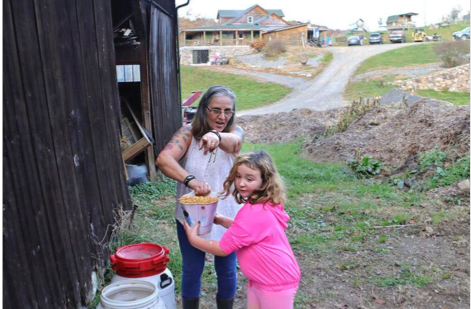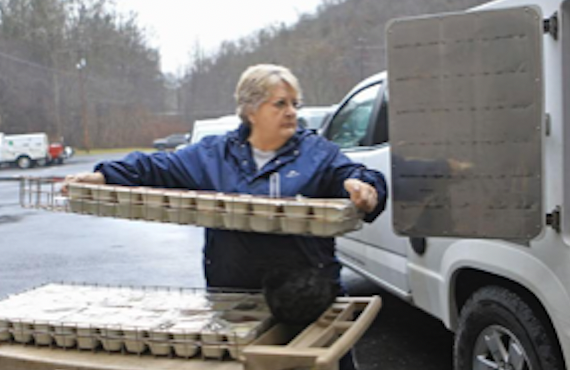
Clean drinking water is a necessity most Americans never have to worry about – unless they live in rural areas of Appalachia. Many communities in southern West Virginia have been on and off boil water advisories for years. There is hardly a day that goes by when a notice does not run in The Register-Herald. The Ravencliff McGraws-Saulsville Public Service District (PSD) in Wyoming County was on a conserve and boil water advisory from before Christmas until late January 2020, when an abandoned coal mine they were using as a water source faltered. Officials say the boil water advisory was issued due to a calibration adjustment needed at the water treatment plant and one final water sample test requirement. It was lifted Jan. 28. The conserve water advisory is, however, still in effect for parts of Wyoming County. Wyoming County Schools officials say they've been using disposable items like Styrofoam trays in school cafeterias in the interim to save water. They also say the water fountains were covered with plastic and schools were relying on jugs of water in the kitchen and to keep students hydrated during the boil water notice. The ongoing water issue in Wyoming County is a prime example of a rural area in Appalachia using every resource it has to scrape by. The Ravencliff McGraws-Saulsville PSD delivers water to close to 1,400 households on an 80-mile stretch of main line. Customers include Southern West Virginia Community and Technical College, Twin Falls Resort State Park, Wyoming Continuous Nursing and Rehabilitation Center, Wyoming County East High School, Glen Fork Elementary and Middle School, along with an assisted living facility in Glen Rogers.
Communities impacted include Jesse, Matheny, Sabine, Glen Rogers, Glen Fork, Ravencliff, Saulsville, McGraws, Key Rock and New Richmond. The water from the local PSD has come out of an abandoned coal mine for years with a demand of about 750 gallons of water per minute. The old mine was a viable option until December 2019 when it started putting out 350 to 400 gallons of water a minute – about half of area demands. Water officials say there’s no way of accurately knowing why the water supply has decelerated because the mine is sealed. They’re assuming structural changes inside the old mine are to blame. “It could be a roof cave-in or floor crack; there’s no way of knowing,” the public service district’s chairman Gene Reid said. All Reid knows is that they need a solution – and quick. The Ravencliff McGraws-Saulsville PSD has been forced to ask the state and U.S. Department of Agriculture (USDA) for grant funding because they don't have the means to fix this problem alone. While communities in larger areas have the financial ability to implement water reservoirs and more advanced water supply systems, financial constraints make that difficult to do in rural areas of Appalachia. The solution is the same one the area has known for years – tap into another abandoned coal mine.
The new mine they want to use is located behind the former John McGraw Grade School building. Wyoming County administrator Mike Goode told commissioners earlier in January the price tag to get a new abandoned mine up and running as a water source will be about $1.2 million. The cost includes placing a pump in the mine shaft, adding two miles of six-inch water line from the mine to the water treatment plant, providing a new power source at the mine site and acquiring a new right-of-way. As of Jan. 29, the total project cost had been changed to $1 million, said Eric Combs, project manager for the Region 1 Planning and Development Council. The Infrastructure Development Jobs Council (IDJC) will vote Feb. 5 on whether to give half of the grant money to fund the project. They’re hoping to get a District 3 Crisis Grant for $472,800 and a $27,200 Soft Cost grant, Combs said. If that money comes through, they’re hoping the USDA will give them the remaining $500,000 to make it happen. During a Jan. 22 commission meeting, Combs said state funding agencies are doing all they can to speed up funding sources to pay for the new permanent water source. The PSD says taking a loan isn’t a viable option. “We have no way of paying loans with our current situation,” he said. In the meantime, they are using a small stream called Milam Creek as a temporary water source while they wait to see if grant money rolls in.
“We have plenty of water at this source,” said Wyoming County Commission president Jason Mullins. “but it is only temporary.” “This is only a Band-Aid,” he said. Water officials have rented a pump and hooked up a hose donated from a local fire department to carry the creek water up a steep hill to their water plant, where it is then treated with chemicals like Del-Pac. When the water shortage originally happened, field workers took shifts working around the clock doing tasks like filling a gas tank on the temporary pump every 20 minutes just to keep the water flowing. That obviously wasn’t sustainable, so they’ve since managed to acquire a diesel tank, so employees aren’t manually filling a gas tank multiple times an hour. Plant operator Quentin Shumate said he’s been working 20 hours a day during the water crisis. This young worker didn’t complain about it though. “No one ever lost water,” Shumate commented quietly. The financial constraints of the water crisis have been difficult for the PSD to bear. They paid workers $10,500 in overtime in December and they are incurring about $500 a month just in fuel to run the pump, Reid says. Goode says the county picked up the cost for the fuel and has also paid for the PSD’s water turbidity testing. Reid says one of the PSD’s customers, Twin Falls State Park, is paying the $4,000-a-month bill to rent the pump they are using to get the water out of Milam Creek – for now. “We are committed to paying them back. They are doing it on credit,” he said. “We have assured them when the money is available, we will pay them back. We are hoping when we get this final grant money that maybe we can use some of that to pay some of it.” Reid says the PSD's electric bill has skyrocketed since the plant is now operating 24 hours a day. They are also incurring more chemical bills than normal to treat the creek water and paying vendors extra to maintain the equipment that is running overtime. “We’re now having to pay for chemicals COD (cash on delivery) because we’re behind in our chemical payments – but we can’t operate without the chemicals,” he said. “We’re paying partial payments or some of them are giving us credit. These are private companies and they can’t keep doing it… Public vendors can’t keep giving us money we can’t pay back in a timely manner,” he added.
Reid says the conserve water advisory, which is needed, is consequentially hurting their bottom line. “Your rates are down because we’ve been on a conserve water order for some time, but that cuts our revenues down and our expenses are going in the other direction. It’s a major deal,” he said. Goode says Wyoming County is “picking up some of the bills for them and some of it is reimbursable.” “The county commission has stepped up to make sure everything keeps going on a steady pace with no issues,” Goode said.
Meanwhile, some locals say they aren't drinking the water even though it's being tested and treated. Water officials say many water systems are supplied from rivers and creeks like Milam Creek, and the water that residents are getting passes all safe drinking standards. One local resident who asked to speak under the condition of anonymity said, “People here don’t want to drink it because it’s coming out of the stream. “I can’t blame them,” she said. A local convenience store owner in Saulsville confirmed that he is stocking and selling more bottled water to area residents than normal. However, “Most people around here are on a fixed income and can’t afford to buy bottled water,” the woman who commented earlier said. Paul Greene, 80, of Saulsville says he is not drinking the water while it is being pumped from the creek. “I don’t want to drink it,” he said. Greene says he’s heard rumors circulating from other residents about the water not being safe to drink, so he’s been driving 25 minutes to the nearest Walmart to buy cases of water in bulk. Walmart offers grocery store pick-up where workers load the water into Greene’s vehicle as he is elderly and cannot carry the water himself. His wife is disabled and cannot help, so Greene says he relies on his son to come unload the water into their home so they can have water they feel comfortable drinking. *** Water officials say things will get dire in this area if the grant money isn't approved. “If we don’t get the grant, in all probability, things are going to be really, really bad,” Reid said. “The current water source is not sufficient to supply it… The water company is not going to be able to pump the amount of water we need.” Although they are still pumping some water out of the original abandoned mine, it is not enough. Reid says he’s afraid the creek they’re using as their secondary source will dry up in late spring or early summer and there is no backup plan currently. There’s also a chance that their temporary pumps could fail at any time – which would mean some residents could go without water until a new plan is implemented. The PSD is currently running its pumps around the clock, minus a 45-minute break during the day in which filters are cleaned. “Our equipment doesn’t get to rest. Our pumps don’t get to cool down,” said Reid. “We can’t do that 24/7 without doing damage to the plant and pumps for an extended period of time. At some point in time, one of the pumps is going to burn up.” This is a “very, very temporary solution,” Reid says. *** Essentially, Wyoming County is in a tough spot. But is another abandoned mine the best decision? Amy Swann, executive director of the Rural Water Association, said, “In the southern coalfields when their water source is water from an abandoned coal mine, you’re always subject to vagaries of those particular strata of rock and substrata of rock. “Are they going to stay still or are they going to move? Is something going to collapse? You just don’t know,” Swann said. But tapping into another mine “is the answer because it’s about the only answer,” she said. Tapping into a water reservoir would be difficult in this area because of topography and “It’s really expensive to build those utility systems in West Virginia,” she said. Also, when the water system in Wyoming County was implemented years ago, coal companies went with the cheapest, quickest option, Swann said. Many of these coal companies are now out of business and the mining companies didn’t leave towns with any maps of where the water piping lies underneath the ground. “When the coal companies left, they just left,” she said. “There’s no mapping… When you put in a new system these lines run under the house and we don’t have any maps, so we don’t know for sure where the lines are. There’s a lot of challenges relevant to a lack of central planning.” Swann says she wishes she had the answer to solve the ongoing water issues in West Virginia. “All of West Virginia’s got water problems,” she said. “There are hard decisions that are being made every month on the infrastructure council.” She says a declining population and declining birth rates make it difficult for “decision-makers to commit loan dollars and make borrowers leery of sending loan dollars to places like that (Wyoming County) where you may or may not get repayment.”







